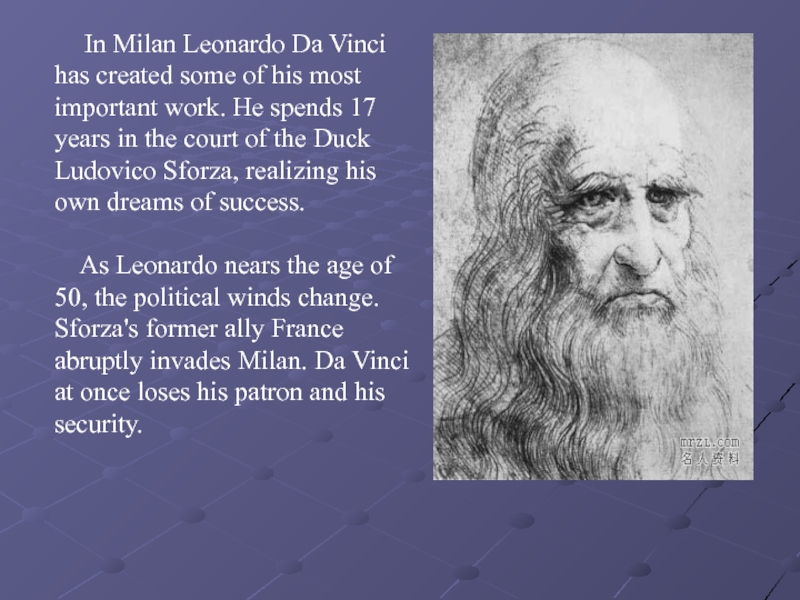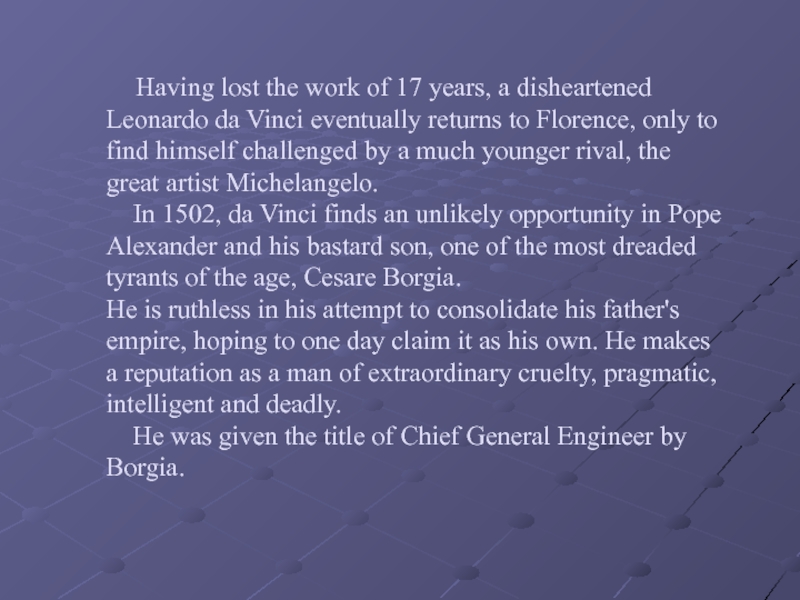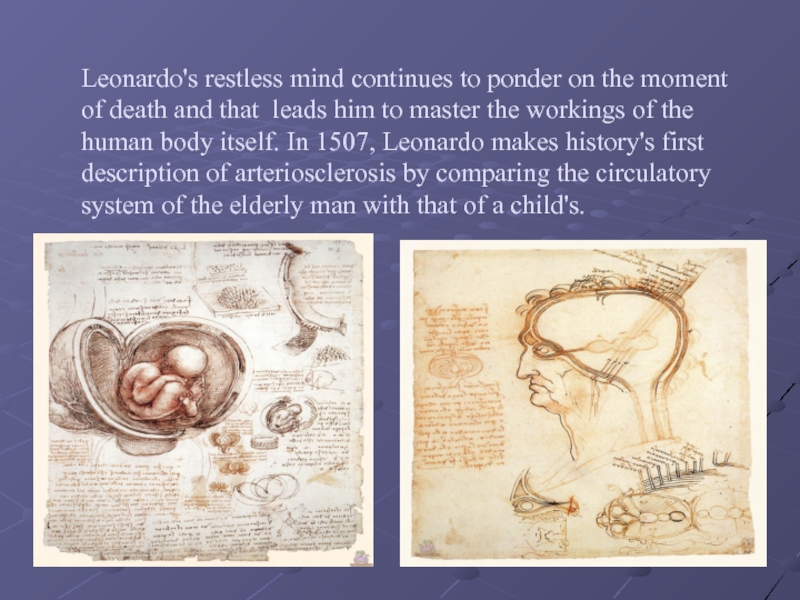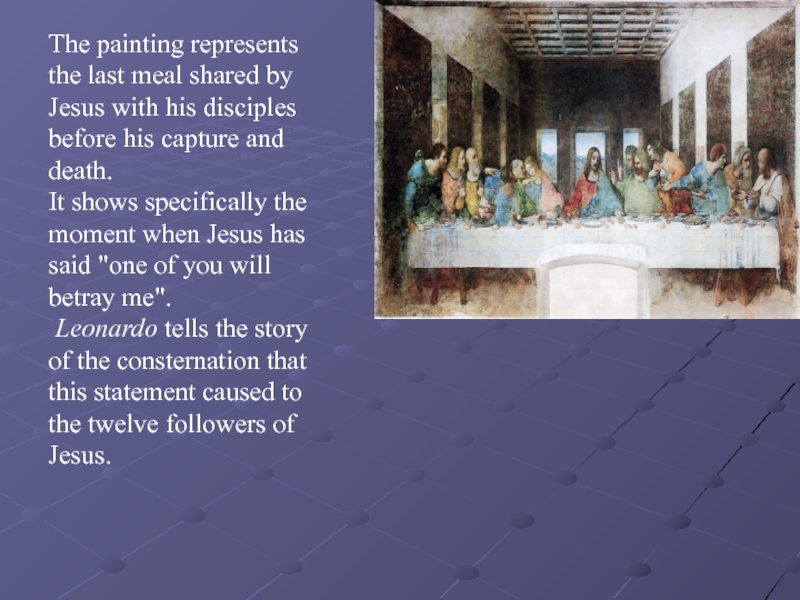Слайд 2
The brief introduction about Leonardo
Leonardo was the
son of Ser Piero da Vinci, a lawyer from Florence,
and his mother, Catharina, was of humble birth and unmarried. He is the bastard child of a respected notary and a poor farmer's daughter. He lives in his father's house, while his mother is left to marry a man of her own class.
Because of his illegitimate status, he cannot even take his father's name. He is known as Leonardo "from Vinci".
His family will spend no money on his formal education.
Слайд 3
In 1468, when Leonardo is
16, his father sends him to Andreadel Verrocchio, a highly
regarded Florentine artist.
Verrocchio agrees to take Leonardo as an apprentice, to give him the experience he needs to one day gain admittance to a guild. Here Leonardo first comes to understand the connection between art and power. The Medici, the ruling family of Florence, often commission paintings from Verrocchio.
Слайд 4 Leonardo studies the cola grande, or great hoist,
which will lift heavy objects to the peak of the
dome, and the swiveling crane of the top. This early exposure to mechanical engineering will have great influence on his later inventions.
Verrocchio and his students are invited to bring their best work to the Medici Palace, to prepare for a visit from the influential Duke of Milan.
Слайд 5 Leonardo is now twenty. He completes his apprenticeship
and has finally joined the guild as a painter, And
as he works,
Leonardo's reputation grows, even reaching the attention of the Medici family.
Leonardo's first great work emerges. It is considered the oldest surviving Leonardo painting. The angel on the left, far in the corner of Verrocchio's The Baptism of Christ, is only a fragment, a tantalizing glimpse, a genius to come.
Слайд 6 In a little more than a decade,
Leonardo da Vince, at age 24, transforms himself from the
bastard son of a notary to a legitimate artist recognized by the Medicis—the most powerful family in Florence.
Слайд 7 Back in Florence, Da Vince, like everyone else,
is caught up in the tension and anxiety of a
pending war. He begins designing ladders and other devices for defending its scaling walls.
As peace at last comes to Florence, Leonardo receives a commission to paint the Adoration of the Magi—an altarpiece for the monastery of San Donato a Scopeto. It is his first important work.
the Adoration of the Magi
Слайд 8But Vinci must set aside his excitement about military designs—the
Duke needs a portrait of his mistress—the Lady with an
Ermine.
The first time a portrait shows the sitter's thoughts or feelings through posture and gestures.
Слайд 9 In Milan Leonardo Da Vinci has created some
of his most important work. He spends 17 years in
the court of the Duck Ludovico Sforza, realizing his own dreams of success.
As Leonardo nears the age of 50, the political winds change. Sforza's former ally France abruptly invades Milan. Da Vinci at once loses his patron and his security.
Слайд 10 Having lost the work of 17 years, a
disheartened Leonardo da Vinci eventually returns to Florence, only to
find himself challenged by a much younger rival, the great artist Michelangelo.
In 1502, da Vinci finds an unlikely opportunity in Pope Alexander and his bastard son, one of the most dreaded tyrants of the age, Cesare Borgia.
He is ruthless in his attempt to consolidate his father's empire, hoping to one day claim it as his own. He makes a reputation as a man of extraordinary cruelty, pragmatic, intelligent and deadly.
He was given the title of Chief General Engineer by Borgia.
Слайд 11
Da vinci leaves the service of Borgia and returns to
Florence and the art of painting, perhaps to explore the
gentler side of human nature.
There he begins the one work for which he will always be remembered. It is called "the Mona Lisa".
Слайд 12Leonardo's restless mind continues to ponder on the moment of
death and that leads him to master the workings of
the human body itself. In 1507, Leonardo makes history's first description of arteriosclerosis by comparing the circulatory system of the elderly man with that of a child's.
Слайд 13 Toward the end of his life in 1517,
King Francis I of France, a great admirer and collector
of his work invites da Vinci and his two assistants, Salai and Francesco Melzi to live on his royal chateau in Cloux.
The king names Leonardo da Vinci favorite painter, engineer and architect. But at 65, Leonardo's triumphs are behind him. A stroke has paralyzed his right arm and his left hand can no longer paint fine details.
In 1519 after months of failing health, Leonardo da Vinci passes into history.
Слайд 14The Virgin and Child with St. Anne
Virgin of the Rocks
Lady
with an Ermine
Слайд 15Portrait of Ginevra de' Benci
St. John the Baptist
The Virgin and
Child with St Anne and St John the Baptist
Слайд 16Among the works created by Leonardo in the 1500s it
is the small portrait known as the Mona Lisa, the
laughing one.
The painting is famous, in particular, for the elusive smile on the woman's face, its mysterious quality brought about perhaps by the fact that the artist has subtly shadowed the corners of the mouth and eyes so that the exact nature of the smile cannot be determined.
Mona Lisa
Слайд 17The painting represents the last meal shared by Jesus with
his disciples before his capture and death.
It shows specifically
the moment when Jesus has said "one of you will betray me".
Leonardo tells the story of the consternation that this statement caused to the twelve followers of Jesus.





































